
North Lincolnshire is a unitary authority area with borough status in Lincolnshire, England. At the 2011 Census, it had a population of 167,446. The administrative centre and largest settlement is Scunthorpe, and the borough also includes the towns of Brigg, Broughton, Haxey, Crowle, Epworth, Bottesford, Winterton, Kirton in Lindsey and Barton-upon-Humber. North Lincolnshire is part of the Yorkshire and the Humber region.
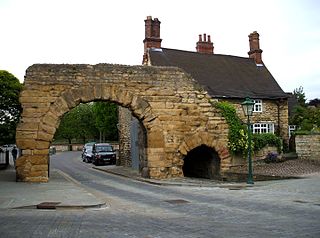
Ermine Street is a major Roman road in England that ran from London (Londinium) to Lincoln and York (Eboracum). The Old English name was Earninga Strǣt (1012), named after a tribe called the Earningas, who inhabited a district later known as Armingford Hundred, around Arrington, Cambridgeshire, and Royston, Hertfordshire. "Armingford", and "Arrington" share the same Old English origin. The original Celtic and Roman names for the route remain unknown. It is also known as the Old North Road from London to where it joins the A1 Great North Road near Godmanchester.

Whitton is a village and civil parish in North Lincolnshire, England. The 2011 census found 212 inhabitants, in 92 households. It is situated at the northern termination of the Lincoln Cliff range of hills, on the south shore of the Humber about 3 miles (4.8 km) below Trent Falls, and 9 miles (14 km) west of Barton-upon-Humber. The parish is bounded on the west by Alkborough, on the east by Winteringham and, to the south, by West Halton.
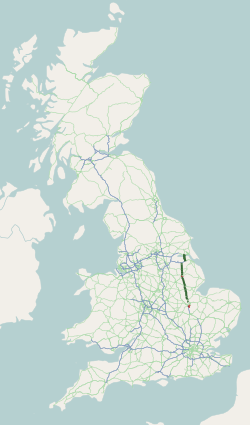
The A15 is a major road in England. It runs north from Peterborough via Market Deeping, Bourne, Sleaford and Lincoln along a variety of ancient, Roman, and Turnpike alignments before it is interrupted at its junction with the M180 near Scawby. The road restarts 10 miles (16 km) east, and then continues north past Barton-upon-Humber, crossing the Humber on the Humber Bridge before terminating at Hessle near Kingston upon Hull.

Winterton is a market town and civil parish in North Lincolnshire, England, 5 miles (8 km) north-east of Scunthorpe. The 2021 census found 4,765 inhabitants living in the town. Winterton is located near the banks of the Humber and is 8 miles (13 km) south-west of the Humber Bridge which can be seen from many parts of the town.
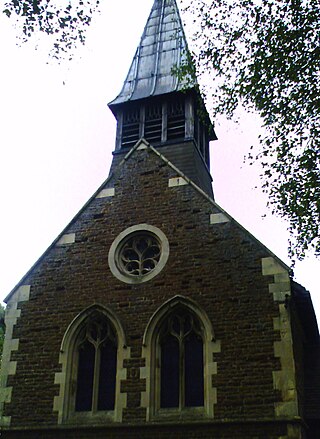
Flixborough is a village and civil parish in North Lincolnshire, England. The population of the civil parish at the 2011 census was 1,664. It is situated near the River Trent, approximately 3 miles (5 km) north-west from Scunthorpe. The village is noted for the 1974 Flixborough disaster.

The Lincoln Cliff or Lincoln Edge is a portion of a major escarpment that runs north–south through Lindsey and Kesteven in central Lincolnshire and is a prominent landscape feature in a generally flat portion of the county. Towards its northern end, near Scunthorpe, it is sometimes referred to as the Trent Cliff. The name preserves an obsolete sense of the word "cliff", which could historically refer to a hillside as well as a precipitous rock face.
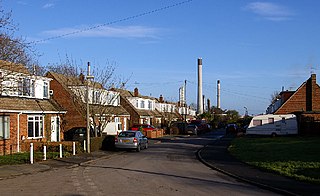
North Killingholme is a small village and civil parish in North Lincolnshire, England.
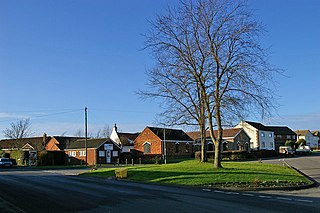
South Killingholme is a village and civil parish in North Lincolnshire, England. The population of the civil parish at the 2011 census was 1,108.

Barrow upon Humber is a village and civil parish in North Lincolnshire, England. The population at the 2011 census was 3,022.

Barton-on-Humber railway station serves the town of Barton-upon-Humber in North Lincolnshire, England.

Barrow Haven is a hamlet and small port in North Lincolnshire, England. It was the site of a former ferry crossing that spanned from the Humber Estuary to Hull, serving as a place for ships and boats crossing the Humber to moor away from the tidal flow. A port continues to exist nearby and the area's rail access is based at the Barrow Haven railway station, a stop on the Barton Line.
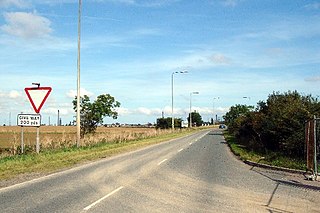
The A1077 road runs through North Lincolnshire, England, between Scunthorpe and South Killingholme.

Welton is a village and civil parish in the East Riding of Yorkshire, England. The parish extends to the bank of the Humber Estuary at its southern extreme, and into the Yorkshire Wolds in the northern part. The A63 road and Hull to Selby railway line both bisect the parish east–west, south of Melton and Welton.

Owston Ferry is a village and civil parish in North Lincolnshire, England. It is situated on the west bank of the River Trent, and 9 miles (14 km) north from Gainsborough. It had a total resident population of 1,128 in 2001 including Kelfield. This increased to 1,328 at the 2011 census. Sometimes referred to as Owston or Ferry, the village forms part of the Isle of Axholme. It is bounded to the west by the A161 road and the village of Haxey. The River Trent is directly to the east. To the north, beyond a number of hamlets and villages, lies the Humber estuary. West Butterwick was originally a part of the township of Owston.
Barton Waterside is a village in North Lincolnshire, England. It is in the civil parish of Barton-upon-Humber. Barton Waterside consists of the former port area at the north end of Barton-upon-Humber. The Community is centred on Barton Haven - a late Anglo-Saxon artificial harbour - which was dug c.1000 AD to create a reliable deep water port for the extreme north of Lindsey. It seems possible that the project was initiated by Peterborough Abbey which had interests in the parish at that time.
The North Lindsey Light Railway (NLLR) was a light railway in North Lincolnshire. It was later absorbed by the Great Central Railway and later, on grouping, it passed to the London and North Eastern Railway. The railway is now mostly closed.

Winteringham railway station was built by the North Lindsey Light Railway in Winteringham, Lincolnshire, England and opened for public service on 15 July 1907 although the first train, a village sports club special, had run two days previously.
Winteringham Haven railway station was a port facility on the south bank of the Humber Estuary, Lincolnshire, England. It was constructed by the North Lindsey Light Railway at the end of a 1⁄2 mile branch line from Winteringham. The railway company provided two chutes to load ships, one for coal the other for slag, a by-product of the iron and steel making process. It was opened on 15 July 1907.

















